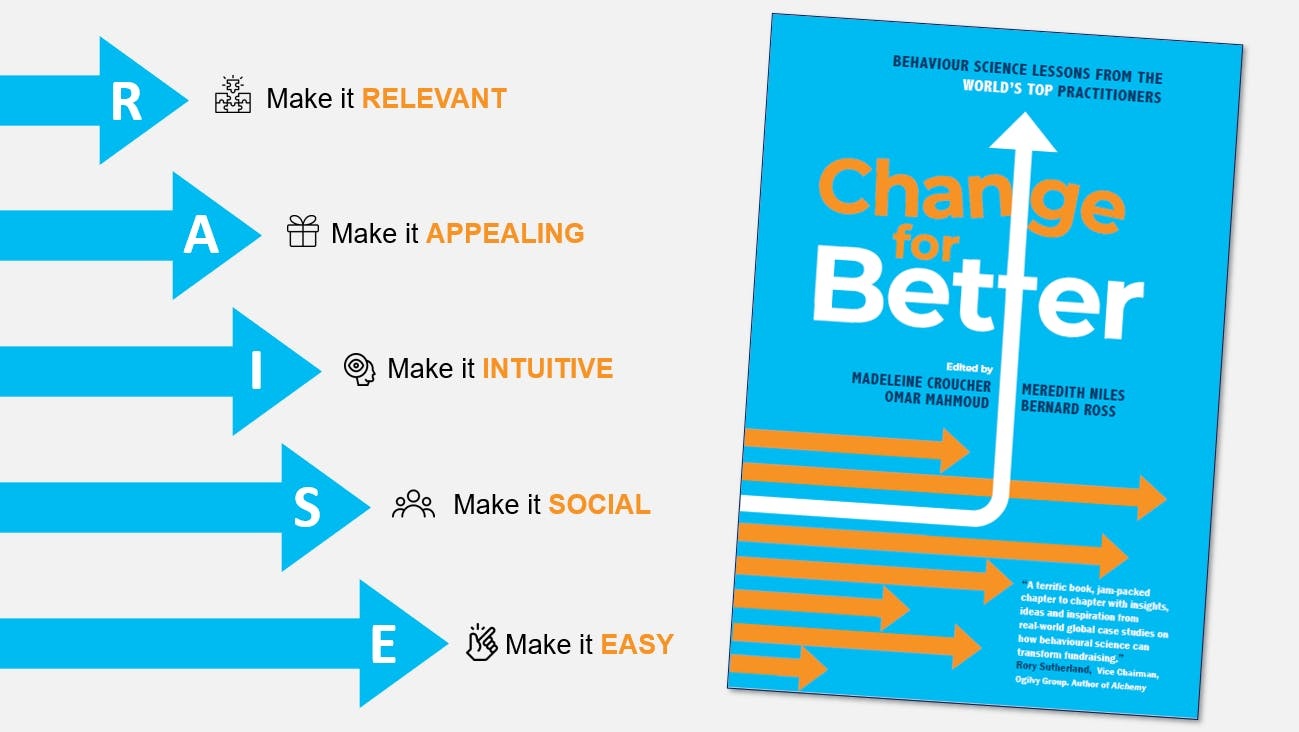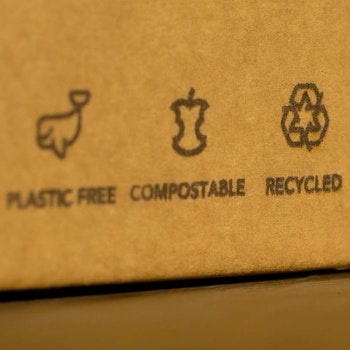
After finding that many of these brilliant case studies were only visible at conferences, my co-editors and I saw an opportunity to share them with the wider sector and beyond. What the book really aims to do is showcase brilliant behavioral science applications and share the learnings with the sector for everyone to benefit from. ‘Change for Better’ consolidates common learnings into a framework – RAISE - that acts as a toolkit for applying behavioural science and testing new ideas.
While the book is primarily focussed on driving fundraising results, we found that the learnings from these global case studies extended to many forms of supporter engagement as well as how brands more broadly can drive engagement in their campaigns.
What is the RAISE framework and why was it developed?
The beauty of the book is the diversity of the case studies. ‘Change for Better’ explores everything from traditional door-to-door fundraising models and direct mail campaigns in Europe, to shifts from community to digital fundraising initiatives in Kenya, to Neuroscience studies exploring the effects of oxytocin on donation behaviour and linguistic analysis of tweets to better understand your audience. However, this this did throw up a bit of a challenge (or an opportunity), to consolidate learnings across this range of channels, causes and markets into a simple easy to use framework for the sector to apply.
RAISE, essentially summarises the key consistent behavioural science strategies leveraged across the 17 case studies in the book. It outlines 5 key strategies that serve as a helpful starting point for driving pro-social action.
Make it Relevant: we know we’re heavily influenced by how information is framed and tend to engage more when it personally resonates - so we look at ways we can make content or the cause more personally meaningful and tap into personal experience.
Make it Appealing: we know we’re more likely to act when we anticipate some kind of intrinsic or extrinsic reward – so we look at ways we can incentivise and create a sense of personal achievement.
Make it Intuitive: we know we’re influenced by many subconscious cues – so we explore how we can trigger certain emotional responses and suggest expected behaviours.
Make it Social: we know we’re highly influenced by others - so we explore how you can best tailor your norms to your audience and use the most relevant messengers.
Make it Easy: we know we perceive things more positively when they require less effort – so we look at ways we can simplify content, repeat asks and focus on singular requests.
What is one of the biggest challenges marketers face (which they might not even realise)?
Many marketers (whether they’re in the private, public or third sector) can be unaware of their own cognitive biases and the impact this has on their communications and campaigns. Something we all fall victim to is The Curse of Knowledge - when we assume that our audience have the same depth of knowledge about our organisation or cause as we do. This can make it difficult to view things through our audiences’ eyes instead of our own.
When we fall into this trap, we might start to make inaccurate assumptions about our audience. We might fail to make something that is seemingly obvious to us, clearly understandable to them. We might miss the chance to tap into our audience’s strongest emotional triggers, or worse still, accidentally tap into triggers that actively repel them.
It’s easy to fall into the trap of communicating what we care about rather than tapping into what the audience really cares about - they may or may not be the same thing.
This is where behavioural science and neuromarketing can be so effective. It helps us uncover the true, sub-conscious motivations of our audience, and design better for them as a result. We can then start to solve for the audience, not the organisation.
Why is testing so valuable?
1. It enables us to surface hidden motivations
Research shows us that people are often not consciously aware of their motivations and so may be unable to accurately predict how they might act in the future. This can make it difficult to unearth a clear picture of why a behaviour is or isn’t occurring from self-reported measures alone. One way to supercharge our audience research is to tap into behavioral science and neuromarketing approaches. These approaches enable us to bypass rational logic, access system 1 and unlock true audience motivations. Whether it’s using a behavioural model such as COM-B to understand all of the different factors that influence a behaviour, using cognitive profiling techniques to uncover how audience’s personality profiles, worldviews and cognitive thinking styles influence decision making, or using Implicit Association Testing to uncover non-conscious, emotional, automatic associations, there are a wealth of testing methods that can help us get to the real why.
2. Context is everything
While many behavioural science strategies are universally powerful, we know that the context in which we make decisions and do behaviours is hugely important! A strategy that works really well in direct mail with one demographic, might have a very different effect in an online environment with a different audience. Similarly, we might see different effects of a social norm when we focus it on a direct action vs the end goal. It’s important to test in order to learn what execution is most effective for your audience in your context. With this in mind, we need to move from “copy and paste” to understanding and design when it comes to applying behavioural science.
3. Testing enables us to learn and adapt
Testing is a continuous learning journey. There is no such thing as a “bad result”, as long as we can learn from it. An unexpected result or absence of any difference at all provides fresh insight. As we see in some of the case studies in Change for Better, sometimes discovering the things that don’t work is even more useful in informing our future approach than the things that do work.
From simple A/B tests online and small-scale field experiments, all the way to full randomised controlled trials – all forms of testing provide valuable insights. Early testing of ideas throughout the strategic and creative development phase is also highly valuable in refining new ideas before we invest in producing and rolling them out.
What else can readers look forward to in Change for Better?
- Learn how to effectively define and diagnose your behavioural challenge to get to more impactful ideas.
- Discover how you can trigger empathy in your audience by simulating the experience of your beneficiaries.
- Understand how you can stimulate oxytocin production to increase trust, generosity, compassion, empathy - and even likelihood of donating!
- Find out why eye gaze is so important and simple cues you can embed in your comms to boost attention to your call to action and drive conversion.
- Be inspired by stories of the gains to be had by testing counterintuitive ideas that simply don’t make sense.
And much more…
Change for Better is available now in paperback and Kindle on Amazon globally.
In the spirit of fundraising, all profits from the book are being donated to Médecins Sans Frontières (Doctors without Borders) to support their important humanitarian work across the world.
You can follow Maddie Croucher on:
You can learn more about Ogilvy Consulting at:

.jpg)





